The Stingray Shuffle is a dance performed by beach-going visitors each year. Here in the Sea of Cortez, every public beach posts signs warning waders to shuffle their feet in shallow water. Stingrays hide from predators by burrowing flush with the sea floor, nearly invisible to us unsuspecting humans. So this sand-agitating, Mr.-Robot -shuffle-step signals the slithery specters to move… hopefully before you step down on one, resulting in a toxic spike jammed in your foot.
But I always thought those billboard notices were a tad overrated. As much as we have been in and around the water, our stingray sightings seemed pretty sporadic. We typically observe them either from the boat or snorkeling in 10-15ft depths, gliding over the sand or just resting on the bottom, one at a time, maybe two. Always comfortably distant… no close encounters… and too fast for film. But this year, I’ve seen more in two weeks than the nearly three seasons we’ve spent in Mexico combined. I’m beginning to think May is Stingray Month.
Agua Verde Video – Sneaky Stingrays
Agua Verde beckons cruisers with its clear, turquoise green water so vibrant it seems fake, like someone dumped in a barrel of Easter egg dye. We anchored at a depth of only 10ft in the east lobe where the sea floor was clearly visible. Peering down into our private fishbowl, we spotted a couple stingrays right away, skimming the white sandy bottom. Later, while swimming around a large rocky outcropping, I saw a couple more, 20ft below. I held my breath, dove down 6ft and tried GoPro stalking. This attempt was futile though – they wisely fled, bolting away like a Stinger missile.
Then, as I was filming a tiny, blue damselfish, another surprised me from behind, gliding by nonchalantly about two feet away. Holy schmeel schmazel. He just about scared my shorty wetsuit right off me. But I actually got that one on video - only by accident. After I gathered my wits, I GoPro stalked that one, successfully this time. Remarkably, this stingray was pretty chill about the whole stalking thing. And I will name him Marky Mark… for being so calm and composed while I dashed after him like paparazzi.
Watching any kind of ray swim is just cool, be they giant manta rays, mobula/eagle rays or stingrays. It is somehow satisfying to witness their wings leisurely undulate, propelling their pancake physique so gracefully. Like swooping underwater butterflies. Only bigger. And with stingers. Don’t forget the stingers…
RayNado
As that sneaky stingray passed me initially, I could have reached out and touched him. But that would have been a bad idea. These are not slimy aquarium kittens with removed stingers to allow petting. These are real stingrays with real barbs, serrated knives essentially, that if shoved into your body really hurt. In fact, as I was in hot pursuit, I thought to myself…self…what are you doing? What if he decides he doesn’t appreciate your quest for good video? And turns around? And calls over some friends? I can picture the movie trailer now: “Stingraynado – The Baja Menace”. Or not. “Raynado”? I’ll work on that one.
So…yah, I slowed down and let Marky flutter away, while he was still in a jolly mood.
Candeleros takes the Cake
Bahia Candeleros is a shallow crescent bay whose crowning glory is the resort oasis of Villa del Palmar. Best known (at least according to us) for their expensive but delicious hamburgers, we travel-weary cruisers could think of nothing else for two days prior. Priorities, people. Stomachs satisfied, snorkeling was priority #2.
I’ve swum the eastern shore here before with not a single ray sighting. But this time we shooed several away in a foot of water just scooting the dinghy onto shore. What the heck?! While prepping our gear, the four of us marveled at several more visible in the clear water. I have never seen a stingray from shore, hanging out 2ft from the water’s edge, noticeably unafraid of our presence… let alone multiples at once.
Mmmmmm. While interesting to observe, I like seeing stingrays by the onesie’s or twosie’s. Not the 10-sies or 20-sies. Not when they might be burrowed in the sand at every footstep. And not when they refuse to scoot away from my shadow. I’m just weird like that.
Fin Flop
Do I really want to go swimming with all these guys? Especially in these initial 2 ft depths. I mean, it’s one thing to get your foot stung (I haven’t yet, fortunately). It’s quite another to put your whole body up for grabs (ala Steve Irwin who was fatally stung in the heart.)
Well, we’re here, let’s do this. Instead of waiting to don my fins in the water though, I put them on at the beach. Better to have that extra 1ft of spacing between me and them, eh? I looked memorably moronic, duck-walking and flopping with my large yellow flippers. My intended crazed commotion (albeit awkward) would have scared away a shark. Or, more likely, attracted one. Hoping I was in the clear, I face-planted into the 2ft pool.
Everywhere I looked, there they were. Crikey.
What IS this place? A stingray incubation facility? Wow. There’s one over there. And another over there. And three down there and two more on the rocks… and on and on. We probably saw 20-30 just in this one small area. Brian and I usually point out interesting things to each other as we are swimming, but with stingrays hovering all around, we felt no need. Until…
Strangely Still Stingrays
Brian called out to me to “come over here”...which sounds a lot like “mmm orrrre earrr” under water. I sashay over to where he is staring at something. Two somethings. One on top of the other, but the bottom one is upside down. OMG. Is THAT what I THINK it is? Yes. Yes indeedy-do. Apparently I was right… this IS a stingray incubation facility.
Leave it to us to stumble upon yet another species, well, uh, having fun. (We came across mating frogs, butterflies and walking sticks last year.) Man, I wish I’d brought the GoPro instead of the camera. Eyeballing me with suspicion as I zoomed in for the shot, the intimate couple was none too thrilled with me invading their private time. Well, you’re doing it here right out in the open, so what do you expect?
“OK…work it… come on, at least pretend you’re having fun…no? OK then…just… say cheese!” Click, click, click.
And here are my up close and personal stingray porn stills. You’re welcome.
Fun Stingray Facts:
- A group of stingrays is called a fever.
- I’ve since learned the month of May IS stingray month. Apparently, they are quite prolific in late spring.
- The three chief species in the Sea of Cortez are Reef, Round or Cortez Stingrays. These types don’t get much bigger than a foot wide and their toxic barbs are not fatally poisonous.
- Peeing on it is NOT the proper treatment for a stingray wound. (Although it can work for jellyfish stings, as would any other mild acid like vinegar.)
- Soaking the affected area in hot water, reportedly over 110degrees, breaks down the toxins faster. The biggest risk is infection, so being several hours away from a doctor in the middle of nowhere is reason enough to be cautious.
----
Stone Scorpionfish
Have you ever wondered: “What’s the ugliest fish in the world?” Well, look no further. Scroll through my gallery to the very end. There you will find what I believe is a Stone Scorpionfish. Unlike an octopus who can transmute himself into the shape of a coral outcropping or rock, a Stone Scorpionfish already looks like one. The fish I found was resting in white sand next to a rock. But this “rock” just looked odd. I wasn’t sure of what I was seeing at first since he was frozen in place… waiting for dinner to glide by, I presume. Not only are they butt-ugly, they too, sport highly toxic spines. If stepped on, the wounds are similar to getting zapped by a stingray. Except worse. An infection can be deadly. With stingrays and scorpionfish and porcupinefish and sea urchins – why is everything in the Sea trying to stab me?

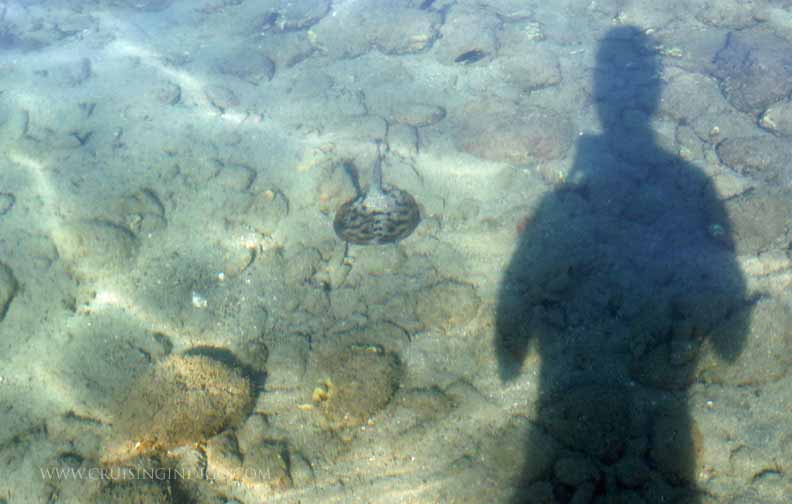

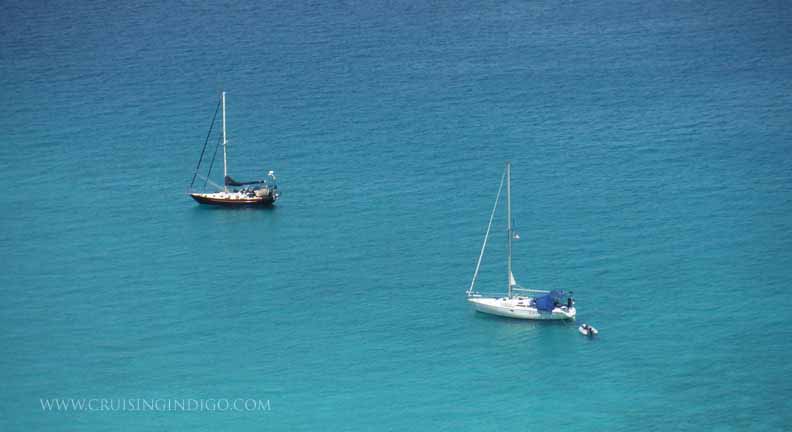

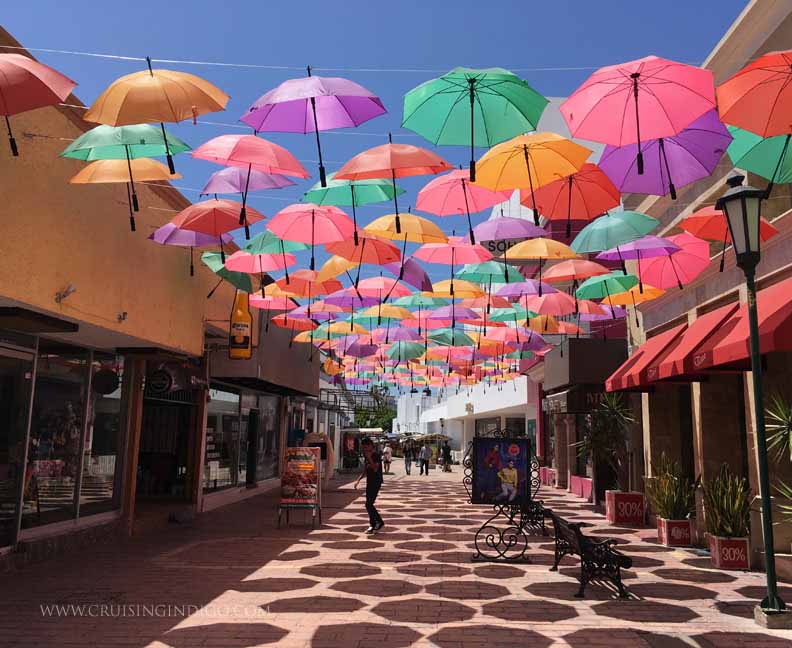
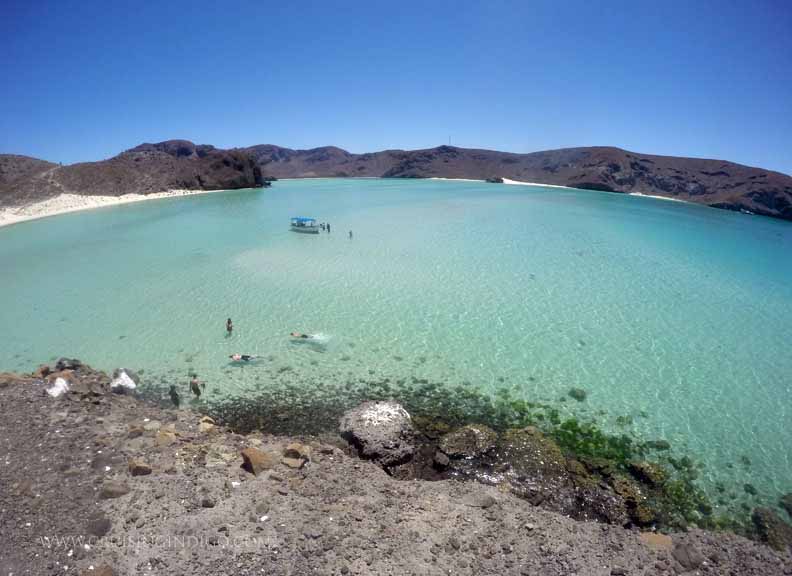


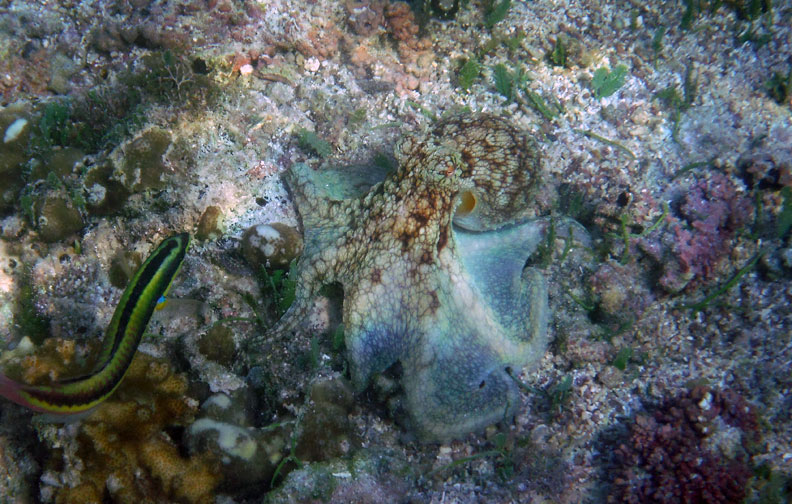
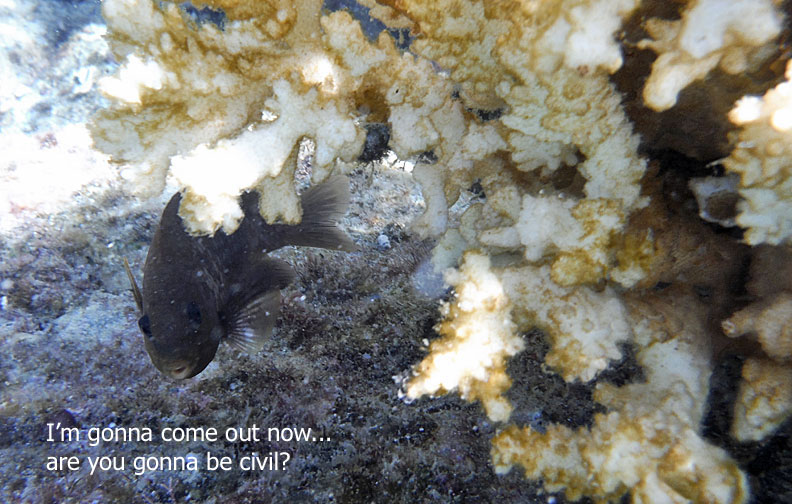
 RSS Feed
RSS Feed
